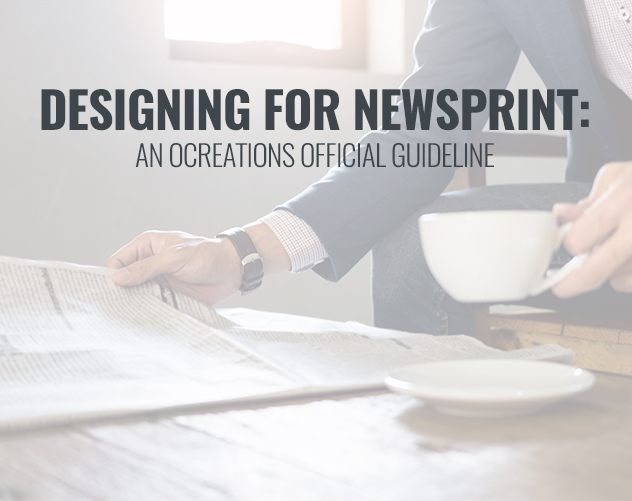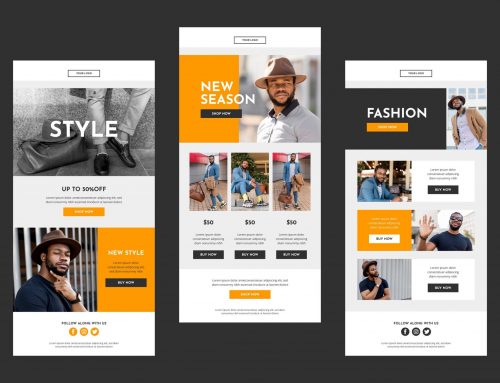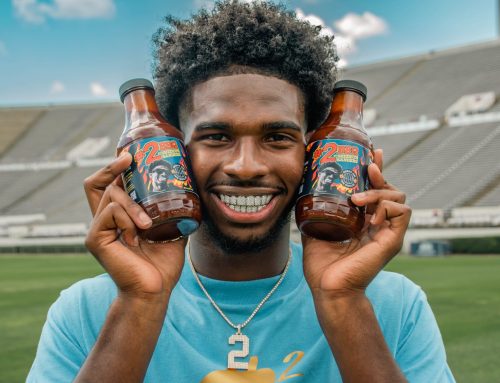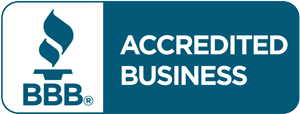NEWSPRINT DESIGN GUIDELINES
As a designer, you have to be able to design for a variety of materials, one being newsprint. Though many newspapers are going digital, a lot of businesses continue to rely on ad space in printed newspapers. Newsprint paper is a tricky material to work with, and prints differently than regular copy paper. As a designer, there are certain specifications and limitations to what you should and should not do when designing for a newspaper ad. Here’s an ocreations guide to designing for newsprint:
SETTING UP YOUR FILE:
- Get the specs.
Before you start to design, always double check specs from the publication. You’ll definitely need to know the size of the ad, as well as color information (CMYK, Black & White, etc.). Also ask if they have any other special instructions for setting up the file for their publication’s press team. Publications are all different and have various column widths, so no publication is the same. For instance, a “quarter sized ad” might be completely different from publication to publication. Or, a full page ad might have a specific amount of bleed (i.e. 0.125”).
COLORS & IMAGES:
- Prepping images for newsprint.
If you’re adding an image or graphic into your design, make sure it is CMYK or Grayscale. Preferred file types are TIFF or EPS. Other file types risk quality being lost in the printing process.
- RGB
There should be no RGB color anywhere in the design, whether it’s a photo, graphic, or text. If you have an RGB photo, take it into Photoshop and change the color mode to CMYK and save a new version of that photo that’s CMYK.
- Contrast
Make sure there is enough contrast in your images. Newsprint has a tendency for photos to turn out dull. For different shades of black, try to maintain a 20% difference between the shades. Also make sure there is enough contrast between text and background colors, etc. As much as it may hurt your creative mind, the more contrast and basic a newsprint ad is, the better it will look in a final print.
- Black & White Ads
Black & White ads need all type to be in black or white, and all photos to be converted to grayscale.
- Be careful when using the color black in newsprint.
When using the color black for graphics or text, make sure it is 100%K black, and not a “rich” black that uses a mix of other CMY colors. The publication may reject your file and make you convert everything to 100K black (take out any cyan, magenta, or yellow in your black swatch).
DESIGN RECOMMENDATIONS:
- Consider a border around your design.
You may not know what other ads your design will be sitting next to, or your ad may not be full bleed. To make sure your ad stays enclosed and does not look like it belongs with another ad, consider placing a thin stroke around your ad space. Also, if your design has a completely white background, definitely consider a border – your ad might look like it’s floating if you don’t give it a border.
- Leave enough room for the logo and contact information.
After all, you ARE advertising your business, right? Getting a message across is important, but readers need to associate that message with a brand and be able to get in touch if they’re interested. Make sure to leave room for that vital information.
- Make sure to give your logo and contact information the best placement possible.
This is YOUR ad, so you have full reign over what it looks like and how it should be laid out. Often times, the contact information sits at the bottom of the ad, as a natural progression of viewers looking at an ad from top to bottom.
- Photos of people.
Make sure photos face into your ad, not looking toward a competitor ad
- Font sizes.
Do not go any smaller than 8pt font. Newspaper readers can range from children to the elderly, so make sure to keep that font size readable. Additionally, fonts that are too small risk the ink bleeding and becoming an unreadable blob of ink. Try to make sure your kerning is appropriate, and your copy does not get to jam-packed in your ad space. Sometimes ads are super tiny, so be careful – test print it and show it to people around your office to see if they have trouble reading the copy in the ad.
DESIGN DON’TS:
- Don’t put small type reversed out of a color or photo backround.
If you do need to use type on a color background, stick with white or back. All other colors are simply too hard to achieve good registration. If you do have to reverse out your copy, make sure the copy is short, and the font is large and bold. Otherwise, it can be hard to read. Again, test print at your office and show it around to your coworkers.
- Don’t use too many special effects.
Gradients do not always print as nicely as they look on the computer screen you’re designing on, so avoid using gradients in your design. Also steer clear from 3D effects like bevels, as well as drop shadows. These effects are meant for digital pieces, and high-end print pieces, not newsprint material paper/printers.
FINALIZING YOUR FILES FOR THE PRESS:
- Outline your fonts.
When prepping your files for print, make sure to outline your fonts. Not all computer have the same fonts. Your design may even be working with a custom purchased font that will definitely not be downloaded to a newspaper publication’s printers. If you send a file that has the live text, you risk their machines defaulting to a font that could completely change your design. With that being said, outline your fonts to be certain that nothing happens to your font(s) (and design) while being transferred to a different computer, and eventually, the printer.
- Double-check the specs.
When you send the ad to the publication, most publications prefer a print-ready PDF (266 to 300 PPI). When you send the files, make sure to note the specs you are sending, and if they catch anything wrong, they’ll red flag and have you adjust. Again, always check the specs with the publication first.
- Full Bleed
If your ad is “full bleed” make sure to send your PDF with the correct full bleed specifications.
Newsprint is one of the original forms of advertising design. Though there are a lot of specifics to keep in mind, and ultimately some modern design elements that get compromised for this print medium. Working with these limitations will make you not only more knowledgeable on print design, but will also make you a more versatile designer that can work with explicit limitations.
If you’re a business interested in working with ocreations on your next newspaper ad, contact us today!







